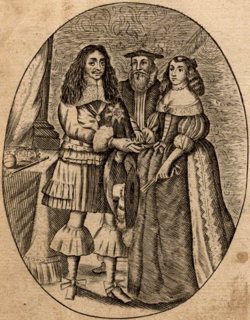Marriage Treaty
The Marriage Treaty or the Anglo-Portuguese Treaty was a treaty of alliance agreed between the Kingdom of England and Portugal concluded in June 23, 1661.[1] It led to the marriage of Charles II of England and Catherine of Braganza, the daughter of John IV of Portugal. The pact renewed the traditional Anglo-Portuguese Alliance between the countries. It was a marriage of state, common in the era.

Background
Charles had recently been restored to the thrones of England, Scotland and Ireland and had been lobbied by both Portugal and the Spanish who pushed rival candidates as a potential wife. Although Charles had previously been allied to Spain through the Treaty of Brussels, his relations with Madrid had become increasingly strained. Spain demanded the return of possessions taken by the English Republic, notably Jamaica, which Charles was willing to agree to. Charles' decision to marry Catherine was attributed to the advice of the influential English statesman Edward Hyde, the 1st Earl of Clarendon.[2] The Portuguese match also received strong support from his Irish ally James Butler, the 1st Duke of Ormonde.
Terms
As well as a cash payment Catherine's dowry also brought with it the settlements of Bombay. England also gained Tangier in North Africa, allowing it to use the port as a naval station or a commercial post for the Levante trade.[3] Under the terms, England had to send 2,000 foot and 500 horses to assist Portugal in its war with Spain.[3] The treaty, under the marriage provision, also stated that the Infanta and her whole family "shall enjoy the free exercise of the Roman Catholic religion."[4]

Over time, however, the acquisition of the two territories came to be regarded as liabilities for England. Charles sold his rights over Bombay to the East India Company. Tangier was maintained until being evacuated by 1684, but was under constant pressure from surrounding Moorish forces. It also became a source of political controversy in England as Whigs suggested that the garrison, which had a large number of Irish Catholics, was designed to be brought over to Britain to impose royal absolutism.[5]
In accordance with the agreement, a force of British and Irish troops under Frederick Schomberg were raised to serve in Portugal's ongoing war of independence against Spain. Portugal was able to successfully secure its independence in 1668.
Charles and Catherine were unable to conceive a child, meaning that in 1685 the throne passed to the King's brother James, Duke of York. Who then married Anne Hyde, and later Mary of Modena.
References
- Gazetteer of the Bombay Presidency: Materials towards a statistical account of the town and island of Bombay (3 vols.) v. 1. History. v. 2. Trade and fortifications. v. 3. Administration, Volume 1. Bombay: Government Central Press. 1893. p. 1.
- Weiser, Brian (2003). Charles II and the Politics of Access. Suffolk: Boydell Press. p. 60. ISBN 978-1-84383-020-7.
- Childs, John (2013). Army of Charles II. Oxon: Routledge. p. 17. ISBN 978-1-134-52859-2.
- Baldwin, David (2010). Royal Prayer: A Surprising History. London: A&C Black. p. 39. ISBN 978-0-8264-2303-0.
- Childs p.115-51
Bibliography
- John, Childs (1976). The Army of Charles II. University Of Toronto Press. ISBN 978-0415846110.
- Davenport, Frances Gardiner; Paullin, Charles Oscar, eds. (2004). European Treaties Bearing on the History of the United States and Its Dependencies: Issue 254. The Lawbook Exchange, Ltd. ISBN 9781584774228.